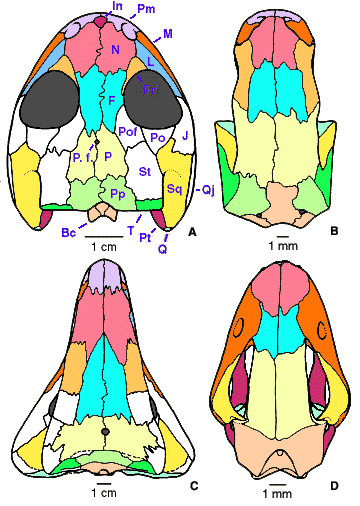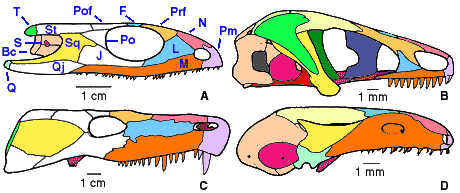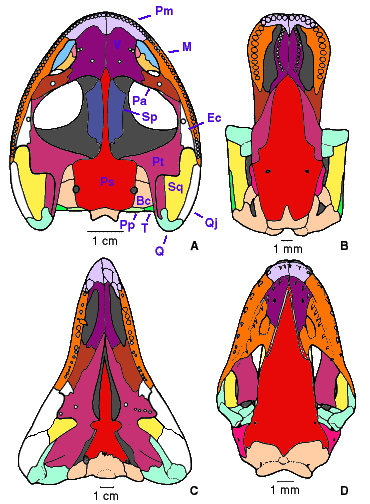The phylogeny of stegocephalians is controversial. Comparisons between various phylogenies are complicated by partly overlapping sets of terminal taxa. However, recent studies by Carroll (1995), Laurin and Reisz (1997, 1999), Laurin (1998a-c), and Vallin and Laurin (2004) agree in most respects. The minor differences between them reflect primarily the choice of included taxa. Here is a strict consensus of the four most parsimonious trees found by Carroll (1995):
========================================== Eusthenopteron
|
| ======================================= Panderichthys
| |
| | ==================================== Acanthostega
| | |
| | | ================================= Ichthyostega
| | | |
| | | | ============================== Crassigyrinus
| | | | |
| | | | | =========================== Loxommatids
| | | | | |
| | | | | | ===================== Colosteids
| | | | | |=====|
| | | | | | ===================== Temnospondyls
| | | | | |
| | | | | | ===================== Anthracosaurs
=====| | | | | | |
===| | | | | | ================== Seymouriamorphs
===| | | | | |
===| | | | | ============ Westlothiania
===| | | | |
===| | | ===| ========= Diadectomorphs
| | | | ===|
| | | | ========= Amniotes
======| | | __
===| | ============ Nectrideans |
===| | |
| |=========== Microsaurs |
| | |
===| === Adelogyrinids |Lepospondyls
| ===| |
======| === Aïstopods |
| |
====== Lysorophids __|
The phylogenies of Carroll (1995), Laurin and Reisz (1997), and Laurin (1998a-c) differ from previous ones in placing lepospondyls (an extinct group of small amphibians that superficially resembled salamanders and snakes) closer to amniotes than to seymouriamorphs. Indeed, few previous studies dealt in any detail with the systematic position of lepospondyls and even the monophyly of this group has been repeatedly questioned (Carroll, 1988 and 1995; Panchen and Smithson, 1988).
Laurin and Reisz (1997), Laurin (1998a-c), and Vallin and Laurin (2004) agreed with Carroll (1995) in most respects, but they also suggested that lissamphibians are derived from lepospondyls:
==================================================== Osteolepiformes
|
| ================================================== Panderichthyidae
| |
| | ============================================== Acanthostega
| | ==|
| | | ============================================== Ichthyostega
| | |
| | | ============================================== Crassigyrinus
| | | |
| | | | ============================================ Loxommatidae
| | | | |
| | | | | =========================== Colosteidae
| | | | | |
| | | | | | ========================= Dendrerpeton
| | | | | | |
| | | | | ==Temnospondyli| | ======================= Ecolsonia
| | | | | | ==| |
| | | | | | ==| ===================== Tersomius
| | | | | | ==|
| | | | | | ===================== Amphibamus
| | | | | |
| | | | | | ============================ Proterogyrinus
| | | | | | ==Embolomeri|
| | | | | | | ============================ Archeria
| | | | | | |
| | | | | | | ====================================== Gephyrostegidae
| | | | | | | |
| | | | | | | | =================== Kotlassia
| | | | | | | | |
| | | | | | | | ==Seymouriamorpha| ================= Seymouria
| | | | | | | | | ==|
| | | | | | | | | ================= Ariekanerpeton
| | | | | | | | |
| | | | | | | | | ============================== Aistopoda
| | | | | | | | | ==|
| | | | | | | | | | ============================== Adelogyrinidae
====| | | | | | | | | |
==| | | | | | | | | ============================== Nectridea
==| | | | | | | | |
| | | | | | | | | ============================ Pantylus
==| | | | | | | | |
==| | | | | | | | ========================== Rhynchonkos
==| | | | | | | |
| | | | | | | | ======================== Brachystelechidae
| | | | | | | | |
| | | | | | | | | ====================== Lysorophia
| | | | | | | | | |
==| | | | | | | | | ==== Triadobatrachus
| | | ==| | | | | | |
==| | | | | | | | | ====| == Discoglossidae
==| | ==| | | | | | ==|
| | ==| | | | | == Pipidae
| | ==| | | |
==| ==| | |======= Hynobiidae
| ==| |
| ==Lissamphibia|======= Sirenidae
| |
| |======= Proteidae
| |
| | ==== Eocaecilia
| | |
| ====| == Rhinatrematidae
| ==|
| == Ichthyophiidae
|
| ================ Limnoscelis
| ==Diadectomorpha|
| | ================ Diadectes
| |
==| ======================= Synapsida
| |
==Amniota| ===================== Captorhinidae
==|
===================== Procolophonidae
However, most scientists have argued that lissamphibians are the descendants of temnospondyls (Bolt, 1969; Milner, 1988; Panchen and Smithson, 1988; Trueb and Cloutier, 1991; Ruta et al. 2003a, b). Comparing the support for these theories is difficult because simply listing synapomorphies of a clade may give only part of the relevant data, but these two theories may be compared by listing synapomorphies present in lissamphibians and their putative closest known relatives (lysorophians, a group of lepospondyls, and the temnospondyl Apateon). In both cases, these synapomorphies appear at various levels, some being unique to lysorophians and lissamphibians (and to Apateon and lissamphibians), some being shared with other lepospondyls (and dissorophoid temnospondyls). Since the lists of characters below are given to explain the relative support of both theories, only synapomorphies unique to lissamphibians and one of the two putative ancestral group (lepospondyls or temnospondyls) have been retained in the lists below; derived characters present in at least some temnospondyls and some lepospondyls have not been retained.
Synapomorphies present in lissamphibians and lysorophians include (Laurin and Reisz, 1997; Laurin 1998a, b):
- Loss of dermal sculpturing. Most early stegocephalians had a distinct sculpturing pattern on their dermal bones. Loss of the pineal foramen. This hole was present between the parietals of most early stegocephalians (Fig. 1A, C), but not in lysorophians and lissamphibians (Fig. 1B, D).
 Click on an image to view larger version & data in a new window
Click on an image to view larger version & data in a new window
Figure 1. Skulls of stegocephalians in dorsal view. A, Tersomius texensis (Temnospondyli); B, Brachydectes elongatus (Lysorophia, Lepospondyli); C, Limnoscelis paludis (Diadectomorpha, Cotylosauria); D, Epicrionops petersi (Gymnophiona, Lissamphibia). Bones lost in lysorophians and lissamphibians are not colored in A and C. Redrawn from A, Carroll (1964); B, Wellstead (1991); C, Fracasso (1983); D, Nussbaum, 1977. Abbreviations: Bc, braincase; F, frontal; In, internasal; J, jugal; L, lacrimal; M, maxilla; N, nasal; P, parietal; P. f., pineal foramen; Pm, premaxilla; Po, postorbital; Pof, postfrontal; Pp, postparietal; Prf, prefrontal; Pt, pterygoid; Q, quadrate; Qj, quadratojugal; Sq, squamosal; St, supratemporal; T, tabular. Elements lost in lysorophians and lissamphibians are white; remaining elements are colored.
- Loss of several cranial bones (postfrontal, postorbital, supratemporal, jugal, quadratojugal, ectopterygoid, coronoids, and postsplenial). The evolution of many groups has been characterized by the loss of several cranial bones, and lissamphibians are no exception (Figs. 1 and 2).
 Click on an image to view larger version & data in a new window
Click on an image to view larger version & data in a new window
Figure 2. Skulls of stegocephalians in lateral view. A, Tersomius texensis (Temnospondyli); B, Brachydectes elongatus (Lysorophia, Lepospondyli); C, Limnoscelis paludis (Diadectomorpha, Cotylosauria); D, Epicrionops petersi (Gymnophiona, Lissamphibia). Bones lost in lysorophians and lissamphibians are not colored in A and C. Redrawn from A, Carroll (1964); B, Wellstead (1991); C, Fracasso (1983); D, Nussbaum, 1977. Abbreviations: Bc, braincase; F, frontal; J, jugal; L, lacrimal; M, maxilla; N, nasal; P, parietal; Pm, premaxilla; Po, postorbital; Pof, postfrontal; Prf, prefrontal; Q, quadrate; Qj, quadratojugal; S, stapes; Sq, squamosal; St, supratemporal; T, tabular.
- Broad parasphenoid with poorly differentiated cultriform process. The parasphenoid is a median endochondral bone in the palate. In temnospondyls and most early stegocephalians, it has a thin cultriform process and a broad body (Fig. 3A, C). In lysorophians and lissamphibians, the body of the parasphenoid is not much wider than the cultriform process and there is no sharp separation between the body and the cultriform process (Fig. 3B, D).
 Click on an image to view larger version & data in a new window
Click on an image to view larger version & data in a new window
Figure 3. Skulls of stegocephalians in palatal view. A, Tersomius texensis (Temnospondyli); B, Brachydectes elongatus (Lysorophia, Lepospondyli); C, Limnoscelis paludis (Diadectomorpha, Cotylosauria); D, Epicrionops petersi (Gymnophiona, Lissamphibia). Bones lost in lysorophians and lissamphibians are not colored in A and C. Redrawn from A, Carroll (1964); B, Wellstead (1991); C, Fracasso (1983); D, Nussbaum, 1977. Abbreviations: Bc, braincase; Ec, ectopterygoid; M, maxilla; Pa, palatine; Pm, premaxilla; Pp, postparietal; Ps, parasphenoid; Pt, pterygoid; Q, quadrate; Qj, quadratojugal; Sp, sphenethmoid; Sq, squamosal; T, tabular; V, vomer.
- Loss of the denticles and fangs on the vomer and palatine, and of the parasymphysial fangs. These structures may have allowed most early stegocephalians to disable and hold a prey in their mouth. The fangs were present in temnospondyls and many early terrestrial vertebrates (Fig. 3A), but they were absent in lysorophians and in tetrapods (Fig. 3B-D). Loss of the labyrinthine infolding. The teeth of most early stegocephalians had deeply infolded enamel (hence the name "labyrinthodont").
- Vertebral centra composed of a single, cylindrical ossification. The centra of most early stegocephalians were composed of two or three crescentic or cylindrical elements.
- Distinct odontoid process present. The odontoid is a small process on the anterior surface of the atlantal (first cervical) centrum that fits into a cavity on the occipital condyle (in the back of the skull). The anterior surface of the centrum of other stegocephalians is flat or concave.
- Anterior surface of atlantal centrum broader than its posterior surface. In most early stegocephalians, the atlantal (first cervical) centrum is cylindrical, and its posterior surface is as broad as its anterior surface.
Synapomorphies of lissamphibians and some temnospondyls include (Trueb and Cloutier, 1991):
- Absence of articulation between anterior ramus of pterygoid and vomer. In most stegocephalians, the pterygoid is sutured to the vomer (Fig. 3B, C), but in some temnospondyls and in lissamphibians (Fig. 3A, D), these two bones do not meet (they are often separated by the palatine, and the pterygoid is smaller).
- Bicuspid, pedicellate teeth. The teeth some juvenile temnospondyls and most lissamphibians have two cusps and a poorly mineralized, fibrous pedicel (between the root and the crown). The teeth of most other stegocephalians are cylindrical and have a strongly mineralized pedicel.
The computer-assisted phylogenetic analyses of Carroll (1995), Laurin and Reisz (1997), and Laurin (1998a-c) considered most of the major groups of terrestrial vertebrates. Earlier studies based on computer-assisted phylogenetic analysis of a data matrix (Gauthier et al., 1988; Trueb and Cloutier, 1991) considered a subset of these taxa. Therefore, the results of these study are difficult to compare with those of Carroll (1995), Laurin and Reisz (1997), and Laurin (1998a-c). However, some studies not based on a data matrix considered all or most of the relevant taxa (Milner, 1988 and 1993; Panchen and Smithson, 1988).
All the phylogenies discussed below suggest that living amphibians are derived from temnospondyls.
Panchen and Smithson (1988) suggested that lepospondyls were a paraphyletic group of amphibians. They proposed two phylogenies because they did not agree about the affinities of Anthracosauroideae (embolomeres). Smithson suggested the following:
=== Temnospondyli + Lissamphibia
===|
===| === Microsauria
===| |
===| | ====== Colosteidae
| | |
| | ========= Nectridea
| |
| ============ Ichthyostegidae
|
=====| ============ Loxommatoidea
| |
| | ========= Crassigyrinus
| | |
| | | === Anthracosauroideae
===| | ===|
===| | === Seymouriamorpha
===|
| === Diadectomorpha
===|
=== Amniota
Panchen preferred this tree:
=== Temnospondyli + Lissamphibia
===|
===| === Microsauria
===| |
===| | ====== Colosteidae
| | |
| | ========= Nectridea
| |
| ============ Ichthyostegidae
|
=====| ============ Loxommatoidea
| |
| | ====== Crassigyrinus
| | ===|
| | | ====== Anthracosauroideae
===| |
===| ====== Seymouriamorpha
| |
===| === Diadectomorpha
===|
=== Amniota
Trueb and Cloutier (1991) provided the most thorough account of the theory that living amphibians are derived from temnospondyls and based their argument on a computer- assisted analysis of a large data matrix. They suggested that branchiosaurs, a group of small and possibly immature temnospondyls, were the closest relatives of lissamphibians. Indeed, Branchiosauridae was a paraphyletic group in their phylogeny:
==================================== Edopoidea
|
| ============================== Trimerorhachoidea
| ===|
| | ============================== Dendrerpeton
| |
| | ============================== Eryopoidea
| | |
| | | ======================== Actiobates
| | | ===|
| | | | ======================== Trematops
| | | |
| | | | ======================== Broiliellus
| | | | |
| | | | |======================= Dissorophus
| | | | |
=====| | | | | =============== Tersomius
===| | | | |
| | | | ===| ============ Amphibamus
===| | | | ===|
===| | | ============ Doleserpeton
| | |
===| | =============== Micromelerpeton
| | | ____
======| | ============ Leptorophus |
| | | |
| | | ========= Schoenfelderpeton |
===| | | | Branchiosaurs
===| |======== Branchiosaurus |
===| |
| === Apateon |
======| ____|
=== Lissamphibia
Trueb and Cloutier (1991) considered more temnospondyl taxa than any other published phylogenetic analysis. However, their matrix and their phylogeny include only temnospondyls and lissamphibians. Therefore, the results of their study were constrained by the assumption that lissamphibians were derived from temnospondyls.
Most scientists now agree that the three main groups of modern amphibians (anurans, urodeles, and gymnophiones) are closely related to each other, but a few dissenting opinions have been expressed (Carroll and Currie, 1975; Carroll and Holmes, 1980). However, all computer-assisted phylogenetic analyses based on morphological characters have suggested that extant amphibians form a closely related group that excludes all known Paleozoic taxa.
The phylogeny of Carroll (1995) suggest that only diadectomorphs and Westlothiana are closely related to amniotes. Laurin (1998a) further suggested that even Westlothiana is not more closely related to amniotes than to lissamphibians. Most previous studies have suggested that at least embolomeres, seymouriamorphs, Gephyrostegus, and Solenodonsaurus were more closely related to amniotes than to lissamphibians (Carroll, 1970; Gauthier et al., 1988; Panchen and Smithson, 1988). However, only Gauthier et al. (1988) based their results on a computerized analysis of a data matrix, and their results were constrained by their choice of taxa, as can be seen in their phylogeny:
=============== Amphibia (temnospondyls and lissamphibians)
|
| ============ Anthracosauroideae (embolomeres)
| |
| | ========= Seymouriamorpha
=====| | |
===| | ====== Solenodonsaurus
===| |
===| === Diadectomorpha
===|
=== Amniota (mammals, reptiles, and birds)
Amphibia was one of the outgroups in Gauthier et al. (1988), and lepospondyls were not included in their analysis. Therefore, it is difficult to compare the results of Gauthier et al. (1988) with the more recent analyses (Carroll, 1995; Laurin and Reisz, in press).
Lombard and Sumida (1992) reviewed recent work on stegocephalians and proposed the following phylogeny by combining the results of several analyses. Their phylogeny represents the accepted consensus in the early 1990s:
================== Ichthyostegalia
|
| ========= Temnospondyli *
| ===|
| | ========= Microsauria
| ===|
| | | ========= Nectridea
| | ===|
| | ========= Aistopoda
=====| |
===| ============ Loxommatoidea
| |
| | ========= Anthracosauroidea
| | |
===| | ====== Seymouriamorpha
===| |
===| === Diadectomorpha
===|
=== Amniota
* Even though Lombard and Sumida (1992) did not explicitly state this, their Temnospondyli probably included Lissamphibia.
All the phylogenies mentioned above suggest that extant amphibians form a monophyletic group that is closely related to amniotes. Therefore, the controversy lies entirely on the identity of the extinct relatives of extant amphibians and amniotes.





 Go to quick links
Go to quick search
Go to navigation for this section of the ToL site
Go to detailed links for the ToL site
Go to quick links
Go to quick search
Go to navigation for this section of the ToL site
Go to detailed links for the ToL site